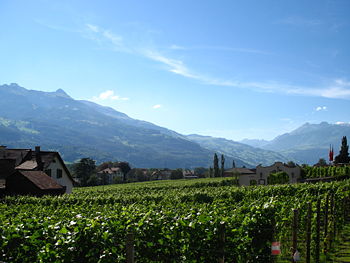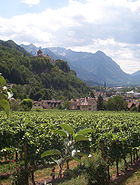
Liechtenstein wine
Encyclopedia

Liechtenstein
The Principality of Liechtenstein is a doubly landlocked alpine country in Central Europe, bordered by Switzerland to the west and south and by Austria to the east. Its area is just over , and it has an estimated population of 35,000. Its capital is Vaduz. The biggest town is Schaan...
is a producer of wine
Wine
Wine is an alcoholic beverage, made of fermented fruit juice, usually from grapes. The natural chemical balance of grapes lets them ferment without the addition of sugars, acids, enzymes, or other nutrients. Grape wine is produced by fermenting crushed grapes using various types of yeast. Yeast...
. The country has a climate ideally suited for the cultivation of vine with mountain slopes facing southwest, calcareous soils and an average of 1,500 hours of sunshine a year. The hot dry wind during the summer months, known as the foehn aids cultivators by having a sweetening effect.
There are over 100 winegrowers in Liechtenstein which produce red and white wines in which despite the small size of the country can produce a significant variety. Liechtenstein is part of the European wine quality system and the international AOC
AOC
AOC may refer to:*Aeronautical Operational Control, a group of applications used for communication of an aircraft with its airline or service partner pendants on the ground...
classification.
History
Viniculture in Liechtenstein dates back to just over two thousand years. Growing began before Christ by a Celtic tribe that had settled in the area, and during Roman timesRoman Empire
The Roman Empire was the post-Republican period of the ancient Roman civilization, characterised by an autocratic form of government and large territorial holdings in Europe and around the Mediterranean....
production increased. After the Romans had been driven out of the area by the Alamanni
Alamanni
The Alamanni, Allemanni, or Alemanni were originally an alliance of Germanic tribes located around the upper Rhine river . One of the earliest references to them is the cognomen Alamannicus assumed by Roman Emperor Caracalla, who ruled the Roman Empire from 211 to 217 and claimed thereby to be...
, production virtually ceased, until the growth of Christianity in the 4th century, when monks encouraged the establishment of new vineyards. During the rule of Charlemagne
Charlemagne
Charlemagne was King of the Franks from 768 and Emperor of the Romans from 800 to his death in 814. He expanded the Frankish kingdom into an empire that incorporated much of Western and Central Europe. During his reign, he conquered Italy and was crowned by Pope Leo III on 25 December 800...
(742–814), many of the municipalities and monasteries possessed their own vineyards.
This time the vineyards surrounding Gutenberg Castle yielded some three thousand gallons of wine a year. Charlemagne did much to alter the method of production, strongly encouraging better hygiene and pressing of the grapes by making it practice for the wine pressers to wash their feet although he was met with considerable opposition.
The grape, Blauburgunder or Pinot Noir
Pinot Noir
Pinot noir is a black wine grape variety of the species Vitis vinifera. The name may also refer to wines created predominantly from Pinot noir grapes...
, was introduced by Henri, duc de Rohan
Henri, duc de Rohan
Henri de Rohan, Viscount then Duke of Rohan , later duke of Rohan, French soldier, writer and leader of the Huguenots, was born at the Château de Blain , in Brittany....
(1579–1638) who strongly encouraged the farmers of the Bündner Herrschaft to cultivate it.

Arlberg Railway
The Arlberg railway, which connects the Austrian cities Innsbruck and Bludenz, is Austria's only east-west mountain railway. The 135.7 km line is referred as Europe's most difficult mountain railway since it is threatened by avalanches, mudslides, rockfalls or floods...
saw an increase in foreign competition and in the first half of the 20th century bad harvests and parasites caused the wine industry collapse. Attempts by the government to sustain the industry by introducing compulsory crop spraying after 1890 failured. However, although the industry had declined significantly, viniculture was still important enough in Vaduz
Vaduz
Vaduz is the capital of the principality of Liechtenstein and the seat of the national parliament. The town, located along the Rhine, has about 5,100 inhabitants , most of whom are Roman Catholic. Its cathedral is the seat of a Roman Catholic archbishop....
that its coat of arms, established on 31 July 1932, pictured bunches of grapes.
Since the 1970s there has been a regrowth of viniculture but as of 2008 only 64 acres (25.9 ha) is under cultivation.
Today, the most popular white wines are Chardonnay
Chardonnay
Chardonnay is a green-skinned grape variety used to make white wine. It is originated from the Burgundy wine region of eastern France but is now grown wherever wine is produced, from England to New Zealand...
, Riesling x Sylvaner, and Gewürztraminer
Gewürztraminer
Gewürztraminer is an aromatic wine grape variety that performs best in cooler climates. It is sometimes referred to colloquially as Gewürz, and in French it is written '...
, while red wines most produced are Blauburgunder, Zweigelt
Zweigelt
Zweigelt is a red wine grape variety developed in 1922, at the Federal Institute for Viticulture and Pomology at Klosterneuburg, Austria, by Fritz Zweigelt. It was a crossing of St. Laurent and Blaufränkisch. It is now the most widely-grown red grape variety in Austria, as well as having some...
, and Blaufränkisch
Blaufränkisch
Blaufränkisch is a dark-skinned variety of grape used for red wine. Blaufränkisch, which is a late-ripening variety gives red wines which are typically rich in tannin and may exhibit a pronounced spicy character...
. The highest vineyard in the country is the Walser
Walser
The Walser are German-speaking people who live in the Alps of Switzerland, Italy, Liechtenstein and Austria. The Walser people are named after the Wallis , the uppermost Rhône River valley...
village of Triesenberg
Triesenberg
Triesenberg is a municipality in Liechtenstein with a population of 2,564. Its area of 30 square kilometers makes it the largest municipality in Liechtenstein. The center of the municipality rests at an elevation of 884-1,000 metres.-History:...
at 850 meters (2800 ft), which has seen some successful experimental growth of the French Léon Millot
Léon Millot
Léon Millot is a red variety of hybrid grape used for wine. It was created in 1911 in the Oberlin Institute in Colmar, Alsace, by the French viticulturist Eugène Kuhlmann by crossing the hybrid grape Millardet et Grasset 101-14 O.P. with Goldriesling, which is Vitis vinifera...
grape variety. Other notable brands are the Zweigelt Selektion Karlsberg Profundo and the FL Premier Brut 1996, a vintage sparkling wine, pressed from Rhine Riesling grapes.
Several places in the country have wine tasting venues. Most notable is the "Hofkellerei des regierenden Fürsten von Liechtenstein", the wine cellars of the Prince of Liechtenstein.


